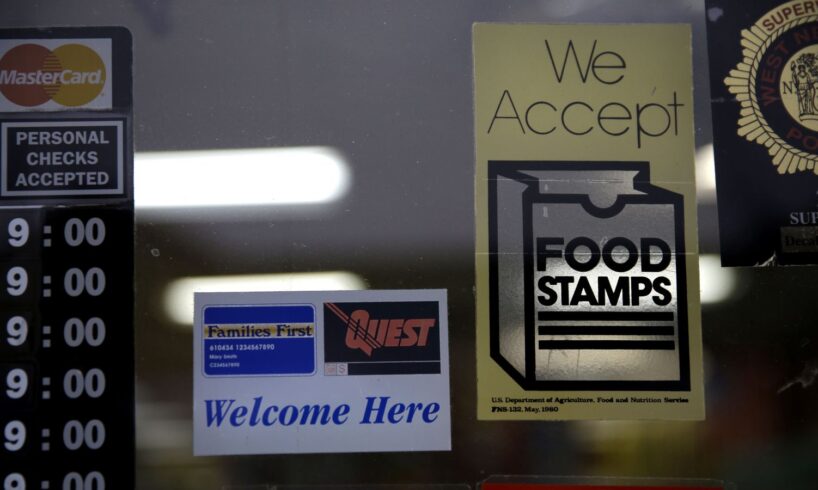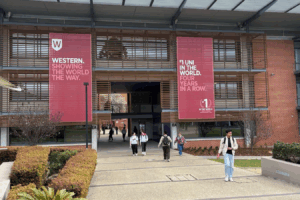
A supermarket displays stickers indicating they accept food stamps in West New York, New Jersey., Monday, Jan. 12, 2015. [AP Photo/Seth Wenig]
One of the most severe impacts of the US government shutdown is the impending November 1 expiration of funding for the Supplemental Nutrition Assistance Program (SNAP), commonly known as food stamps. While the immediate effect of the cutoff will vary by state due to the joint administration of the program by state and federal agencies, the impact on workers and their families will be devastating.
Forty-two million Americans living near or below the official poverty line rely on SNAP benefits as a lifeline—although insufficient—for obtaining food to stave off hunger. While SNAP has about $6 billion in contingency funds to cover the program through most of November, the US Department of Agriculture (USDA) claims it is legally prohibited from using these funds as they are earmarked for natural disasters or similar emergencies.
That the USDA does not consider the threatened hunger and starvation of millions of American adults and children a disaster or emergency is but one expression of the class war character of the government shutdown. It demonstrates that these policies have been explicitly designed to attack the basic social right of the working class to plentiful, nutritious food to maintain a healthy life.
After the government released its 2024 report in the “USDA Household Food Security” series on October 22, the White House said it would be the last such study. Key findings showed an overall rise in food insecurity, with nearly 47.4 million people living in food insecure households, including 13.8 million children. The USDA claimed, “These redundant, costly, politicized, and extraneous studies do nothing more than fear monger.” In a press release in September announcing the decision to scrap the report, the agency claimed:
The questions used to collect the data are entirely subjective and do not present an accurate picture of actual food security. … The data is rife with inaccuracies slanted to create a narrative that is not representative of what is actually happening in the countryside as we are currently experiencing lower poverty rates, increasing wages, and job growth under the Trump Administration.
Democrats in Congress are appealing to Trump and their “Republican colleagues” to work with them to come to a bipartisan agreement to end the shutdown. But it is clear the Trump administration has no intention of entering into any serious negotiations and has seized on the shutdown to enact massive cuts to federal jobs and social programs.
Cuts to SNAP in Trump’s “One Big Beautiful Bill”
On July 4, 2025, Trump signed into law his “One Big Beautiful Bill Act” (OBBBA), which faced no real opposition from the Democrats, who chose instead to plead with Trump for compromises. Most importantly, they failed to organize mass protests to a bill that includes permanent extensions to Trump era tax cuts, large increases to defense and border spending and sharp cuts to Medicaid and food assistance programs. This is because the Democrats are far more fearful of the rising popular outrage over Trump’s policies than they are to the president and his cohorts’ fascistic drive to dictatorship.
Mehring Books
The Wuhan Lab Lie and the Fight for Scientific Truth
This pamphlet provides an overview of the principled stand taken by the WSWS against the far-right Wuhan Lab Lie. It is essential reading for all those seeking to defend science and public health.
Components of the OBBBA were put in motion beginning in July 2025, with most major elements applying through the remainder of the decade, with some expiring or phasing out after 2029. A particularly brutal aspect of the OBBBA is $186 billion in cuts and restrictions placed on SNAP benefits.
As of 2022, more than 1 in 10 people in the US received SNAP benefits, and 20 percent of children lived in families receiving SNAP. The program allows low-income individuals to pay for food at authorized food retailers, with restrictions on the type of items that may be purchased, up to a monetary limit. The average monthly benefit in practice is $187.20 a month per person, about $6 a day or $2 a meal.
The maximum the program allows for a family of four is $973, about $8 a day or $2.60 per meal. More than a third of families receiving SNAP benefits qualify for the maximum benefit. Many of these same families are also forced to rely on food pantries. Not surprisingly, four out of five people receiving SNAP benefits report that they are not enough to cover their food needs.
The US Department of Agriculture and other federal and state agencies are full of demeaning and patronizing advice to SNAP recipients for stretching their benefits: Buy staple food, such as rice, beans and pasta, in bulk; use coupons, store apps and loyalty programs to access discounts; avoid impulse purchases.
As far as the wealthy are concerned, however, the sky is the limit. In New York City, home to 72 Michelin-starred restaurants, the average price of a Michelin-starred meal is $258 per person, excluding drinks, service charges and gratuity, according to Chef’s Pencil. The website estimates that these additional costs could easily double the final bill. Japanese restaurant Masa, which features the Hinoki Counter Experience, was the first American restaurant to break the $1,000 meal mark. In other words, one super-rich diner could spend more on one meal than the poorest family of four receives in SNAP benefits in an entire month.
Even if the shutdown is ended and SNAP benefits are restored, the cuts and restrictions to SNAP in the OBBBA will result in 22.3 million families losing their SNAP benefits in part or whole and millions more being excluded in the future.
Food stamps were first introduced during the Great Depression but were discontinued in the 1940s and only reestablished by the Food Stamp Act of 1964. By 1979, 20 million people were using food stamps, and their use significantly reduced hunger and malnutrition. The program’s name was changed to SNAP in 2008.
Historically, food stamps have been shown to enable families to purchase healthier food and free up resources that can be used for health-promoting activities and medical care, according to the Center on Budget and Policy Priorities (CBPP). It writes:
SNAP reduces the overall prevalence of food insecurity by as much as 30 percent, and is even more effective among children and those with “very low food security,” that is, when one or more household members have to skip meals or otherwise eat less during the year due to lack of money.
Restrictions were placed on these benefits, proven to reduce hunger, starting with the Reagan administration and continuing through successive Republican and Democratic administrations. Food stamps were made less accessible under the Clinton administration, along with its moves to “end welfare as we know it.” The cuts in the OBBBA, however, represent an unprecedented assault on SNAP, following the agenda laid out in the reactionary Project 2025, initiated by the Heritage Foundation. Trump’s budget director, Russell Vought, who is overseeing attacks on social programs and layoffs during the shutdown, co-authored Project 2025.
New SNAP restrictions and work requirements
In addition to the raw funding cuts of $186 billion, OBBBA puts into place restrictions and work requirements on those who receive SNAP benefits. The bill creates administrative roadblocks for those who need assistance and incentivizes states to restrict enrollment by shifting costs of the program onto the states. These include:
Widening work requirements: The provision that requires recipients to work 30 hours a week and pursue work is introduced to new age groups and categories of recipients who were previously exempt, including those whose youngest child is under 18 but over 14, people aged over 55, veterans and the homeless. Waiver restrictions: States previously were able to waive work requirements in areas with poor employment prospects. Now most waivers are limited to areas with an official unemployment rate of 10 percent. The last time the official US unemployment rate reached 10 percent was in October 2009 during the Great Recession.New bureaucratic roadblocks to receiving SNAP, such as requiring recipients to document their utility costs.Federal funding for SNAP administrative needs slashed in half: This cut is in addition to increased funding penalties for administrative errors at the state level, incentivizing states to restrict the number of applicants.
All these changes will further complicate the efforts of those in need to qualify for and continue to receive SNAP benefits, threatening an upsurge in hunger in the US. As of 2023, 13.5 percent of Americans were already food insecure, and one in five children was hungry. These conditions will impact the entire economy, as food purchases by SNAP recipients have long tended to have a stabilizing effect on the economy, particularly the food industry.
The cuts in the OBBBA to SNAP, as well as to Medicaid and Social Security, are part of a massive assault on the living standards and well-being of workers by the capitalist oligarchy, clawing back social programs won by the working class in over a century of struggle. These programs, which were secured by workers in an earlier period when American capitalism was still on the ascent, are being stripped away alongside democratic rights in an unmistakable turn toward fascistic forms of rule by the capitalist oligarchy.
The ruling class, which can permit no checks or limitations on its accumulation of wealth, demands workers pay for the debts and decline of American capitalism. It is attempting to bring to life a reactionary blueprint in which workers are expected to labor for the absolute bare minimum in pay, while robbing workers and their families of the necessary nutrition to sustain a healthy life.
The cuts to SNAP in Trump’s bill, along with other policies that increase economic inequality and attack public health, are aimed at further reducing life expectancy and prioritizing profit over human need. The Socialist Equality Party says access to food, not only to meet basic nutritional needs but to thrive, is a basic social right that must be fought for by the working class as part of a socialist program.
Join the fight to end the COVID-19 pandemic
Someone from the Socialist Equality Party or the WSWS in your region will contact you promptly.





